We spend so much time in our beds that we might as well make the most of it. If you enjoy laying down while binging your favorite TV show then mounting a TV in the bedroom will be something you will want to look into.
Whether it is a flat-screen TV, an LCD, or LED, one can be successfully mounted in your bedroom at the ideal height and position.
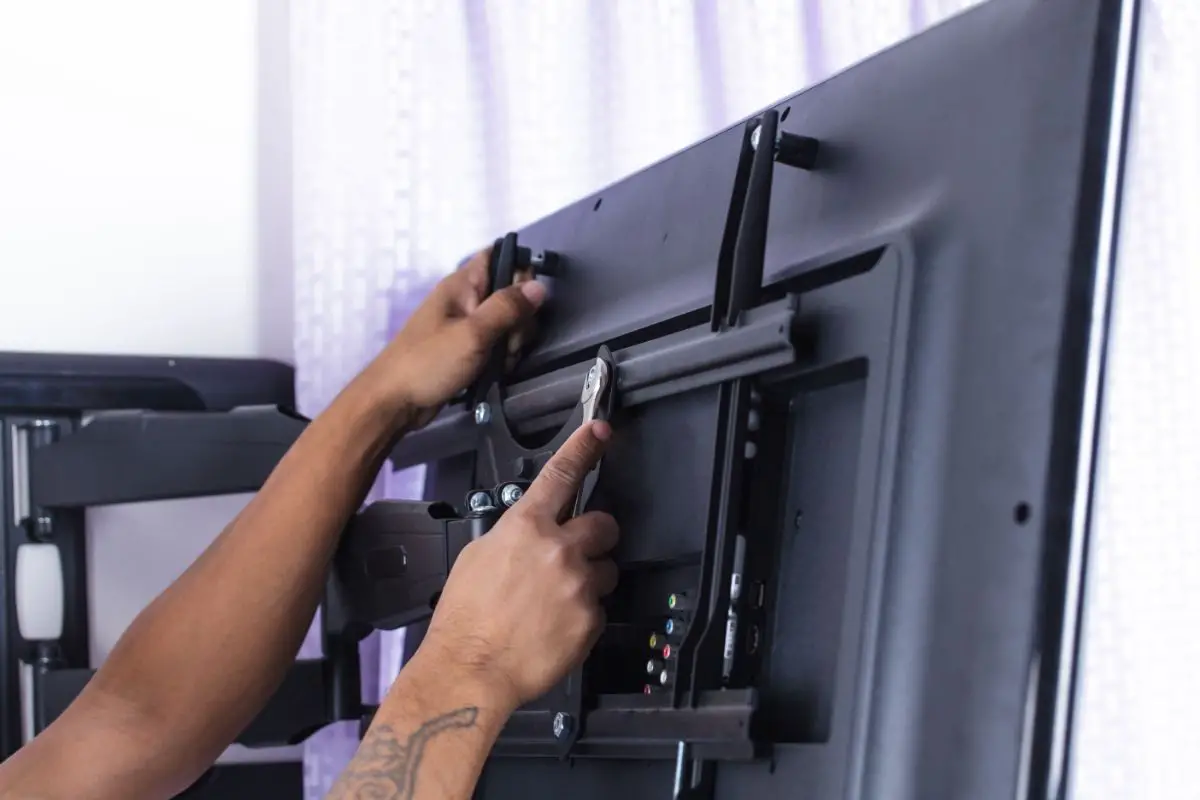
While the decision to have a TV in your bedroom should be a relatively simple one, the setup has to be just right.
There is little point in having a TV mounted in your bedroom if you are straining to glimpse the screen while watching a TV show or film, especially while being positioned uncomfortably.
That undoubtedly includes the optimum viewing angle which will be determined by how high it is mounted, but also the right lighting and the right sound system.
Make sure you avoid neck ache when watching TV from your bedroom as we look at how high to mount a TV.
We will also look at various ideas for where to put the TV in your bedroom, how it can be installed, how big it should be, and how important the lighting and sound system is.
The Correct Height For The TV In Your Bedroom
Having a TV in your bedroom can make a real difference to your day, and night. Waking up and catching up with the morning news to set you up for the day with the weather forecast and traffic information too.
At night, you can relax while watching a film or TV show while lying in bed to while away the hours before you submit to slumber.
Finding the right height for mounting the TV in your bedroom has a lot to do with the distance from your bed to the wall.
The size of your wall has to be taken into account as well as the definition of the TV and how heavy it may be. Find the right size, then you can calculate the correct viewing angle, and then you can find the correct height.
Not Too High For The Power Outlet
The correct height also means finding a spot on the wall that is relatively close to a power outlet.
Being able to discreetly have the wires reaching a power outlet can mean a clean aesthetic in your bedroom and no cables lying around that may act as hazards.
The cable also has to be long enough to reach the power outlet as you do not want to have to use an extension cord.
Just Like A Piece Of Art
One thing to remember is that you should treat the position of your TV as you would a piece of art.
It should take an ideal spot on your bedroom wall to be enjoyed and it can be viewed comfortably wherever you decide to view it from.
Whether lying down in your bed, sitting up, or as soon as you enter the room.
The height is important yet so is the versatility in that you can use a rotating bracket to turn the screen to change the viewing angle to your preference.
The Right Viewing Distance
The correct height also means that the center of the TV should be at your eye level for a perpendicular viewing experience.
That may not be the case in your bedroom, depending on how you choose to position your body to watch it.
The distance from your eyes to the TV could also be important and if the TV is too big then it should be placed at a significant distance away.
If you divide the screen size by 0.55, you should be able to calculate the ideal viewing distance.
Take a smaller TV for instance, at only 42-inches in size, you would need a viewing distance of 76 inches.
The calculation means that you need just slightly less than double the display size to reach the ideal viewing distance.
A truly large TV at 85 inches in size would need a viewing distance of 154 inches so you would need a large room to accommodate such a substantially-sized TV.
Location Ideas For The TV In Your Bedroom
There are several ways to mount the TV on your bedroom wall rather than simply placing it there on its own.
You could use the TV as part of a storage solution, as an entertainment centerpiece for the entire room, or use any available space.
A Central TV Cabinet
If you do not have a cabinet already that can house your TV then you can simply buy one for that primary use.
The cabinet can also house a Blu-ray player or a satellite TV receiver and keep them discreetly out of sight.
There may also be room to store your Blu-rays and DVDs so they are within reach when you need them.
They can also take up some space so as long as your bedroom is large enough it should not prove too cumbersome.
A Wooden TV Stand
Another storage solution that can suit your TV is a purpose-built wooden TV stand. Wood is an ideal material for how classy it can look in a bedroom.
The TV stand can be placed lower to the floor so can still be substantially sized and still provide some storage space.
Fiber Panels
Without using a stand or cabinet, you can still create your own space with your own shelves. One solution is fiber panels which can look elegant in a modern styled bedroom.
The material is long-lasting and can be built to dimensions that suit whatever storage needs you desire. The fiber panels can also be in a color to suit your bedroom with the TV taking center stage in the middle.
Alternative Locations For Your TV
The TV does not have to be mounted onto your TV wall and as soon as you establish that, you can think about alternative locations for it.
Take your pick from the following suggestions and you may want to consider other spots that you had not thought of before.
Begin by considering the entire layout of your bedroom including where the dresser would go, and where you might have a faucet or a bedside table.
There may be pieces of art you want to give a prominent position to on your wall and soon enough the right spot for your TV should make itself known.
On A Piece Of Furniture
If you shudder at the thought of mounting your highly-prized TV on the bedroom wall then you can still have it across from your bed.
Watching TV in bed is one of life’s little pleasures and it is also the easiest, most basic option to choose.
We spend a lot of our lives in bed and having the TV directly across makes for clear sightlines and comfortable viewing.
Should you have a dresser or a low-profile piece of furniture then you can simply place the TV on there which may be ideal if you have a small room.
Having the TV either on or above the dresser also means that you could watch TV while getting ready.
The ideal height should be about a foot higher than the dresser as you may have some toiletries or fragrances that are placed on the dresser.
That really should not obscure your view, especially if you are sitting down and using a mirror on the dresser.
In A Nook Or Cabinet
Should you prefer to have the TV with the possibility of being hidden then find a nook in your bedroom and put it there.
This may be ideal if you have a cabinet or closet that you want to make use of which is ideally sized to house your TV set.
There may be drawers underneath that you could still use though on the days when you do not want to see a TV in your bedroom, you can simply close the doors.
Having a TV set in your bedroom should not mean giving up on storage space. With the TV housed in a wall inlet, it can be out of sight and out of mind while still making good use of an oddly-sized space.
If the nook is directly opposite your bed then great, if not you can still see it. With the TV out of sight, you can create a clean aesthetic for your bedroom with no distractions apart from perhaps a few trinkets and the odd book.
At A Right Angle
Having the TV directly across from your bed may seem ideal, but not if you do not watch TV in bed.
If you prefer to read in bed then having the TV in that location may feel imposing so having it at a right angle means you can have it on in the background.
Perhaps you have a piece of art in mind that you would prefer to gaze at while you are lying in bed instead of having the TV on.
The TV does not necessarily have to take pride of place in your bedroom, especially if you do not spend that much time watching TV.
Over Your Desk
Anyone with a home office in their bedroom will know that it really helps to utilize the entire space. A modern TV will have inputs that mean it could be used as a second screen.
If you are getting sick of staring at your laptop and want to see the bigger picture then using a TV over your desk may be ideal.
It may also be an option to place the desk for your home office in front of your bed so the TV still sits in the optimum position for watching in bed.
This is a great idea for anyone working in a studio apartment who prefers to simply leap out of bed and get to work.
If you prefer to watch TV in bed too then have it in the right place for work and relaxation purposes.
Mixed-Media Gallery Wall
For those who do not want the TV to dominate their bedroom wall, use a mixed-media gallery wall to reduce the focus.
The TV can still have the optimum viewing angle to be seen while lying in bed yet you can have it alongside a mirror, a piece of art, or maybe a family photo.
This is a typically off-beat design but could really work if you want to suggest that the TV falls in line with the other hangings in your bedroom.
The mixed-media gallery wall is also ideal for those small spaces as it can look a little odd if you have so much space to use up and decide to crowd the TV.
If your space is compact then have a TV for entertainment, a piece of art for sophistication, and a family photo for sentimental value.
Ideal Mounting Height From The Floor To The Bottom Of The Screen Based On Screen Size
The larger the TV, the lower the optimal distance from the floor to the bottom of the screen. This has a lot to do with how high your walls in your bedroom are and making sure you get the viewing angle just right.
For instance, TVs are measured in the number of inches when measured diagonally across the screen.
Typical TV classes are from 43 inches to around 85 inches, though they can be bigger or smaller.
The distance from the middle of the TV screen to the floor should be around 42 inches, which explains why a larger TV screen will be closer down to the floor than a smaller sized one.
To work it out for each TV size, you need to halve the screen height then take that number away from 42 to find out how many inches it needs to be off the floor.
Smaller TVs
One of the smallest-sized TV sizes is 32 inches which will have a TV screen height of around 16 inches, the mounting height would be high at 34 inches.
For a 43-inch TV class, the TV screen height will measure 22 inches and the optimal distance from the bottom of the screen to the floor will be 31 inches.
The next TV class up should be 50 inches, which is a nice round number. For that size, the TV screen height will be 25 and a half inches with the optimal distance being a little less at 29.7 inches.
A 55-inch TV class should have a TV height of 27 inches which would determine the mounting height at 28.5 inches.
Next up is the 60-inch TV class which will have a TV screen height of 29 and a half inches and will only need a 27-inch gap from the floor to the bottom of the screen.
The Larger TVs
At a TV class size of 65-inches, the TV height will be 32 inches and the mounting height will be 26 inches.
A slightly bigger screen at 75 inches will have a TV height of 37 inches and should determine a mounting height of 23.5 inches.
The two large TV classes are between 75-inch and 85-inch so you should be prepared to have a large distance away from the TV to your bed as it can feel quite enveloping.
For a 75-inch TV class, the TV screen height will be 37 inches and it will only need to be 22 inches off the floor to the bottom of the screen.
An 80-inch-sized screen will have a TV height of 40 inches and a mounting height of 22 inches. An 85-inch TV is substantial with a height of 42 inches for the screen alone and it will only need to be 21 inches off the floor.
Find The Right Size
It is worth bearing in mind that you need to find a TV of the right size for your viewing pleasure. If the screen definition is high enough then you may not need it to be so huge and dominate your wall.
The viewing angle also has to be right for how you enjoy watching TV as you may prefer to sit up in bed and watch it directly in front of you.
However, if you prefer to watch it lying down then the viewing angle may be reduced but not by too much.
Get The Viewing Angle Right
According to the Society of Motion Picture and Television Engineers, the viewing angle should not be greater than 30 degrees.
This is to ensure that you are not straining your neck to view the TV and it should have a comfortable sightline.
If you watch the TV while reclined then that could comfortably mean a viewing angle as low as between 10 and 15 degrees.
Further Considerations
Aside from the mounting height, there are further considerations that you need to make to find out where to put your TV in the bedroom.
These include the TV dimensions, angle of recline, height of the eye-level from the floor, and viewing range.
Every factor can be included in a final formula that could prove really helpful when working out the height of your TV mounting.
TV Dimensions (TVD)
The TV dimensions should be on the box or be the key measurement when you click ‘add to basket’. Even if it is not, you can measure it when it arrives, and will be the number of inches measured diagonally.
This includes the screen, as well as the bevel which can be seen as the frame, though many TVs have such huge displays that they have a tiny bevel.
Angle Of Recline (RA)
Your seated or reclining position will also help determine the eventual position of the TV in your bedroom.
For instance, if you sit up straight in bed and make a 90-degree angle with your upper body and the floor then the angle of recline is zero.
In a reclined position when you are lying down in bed, the angle of recline is higher and if you are leaning back on the bed then this may be around 10 to 15 degrees.
Height Of The Eye Level From The Floor (ELH)
The angle of recline goes hand in hand with your own seated position, and the eye-level at that position, which are key considerations for where your TV should be.
This is the height of your eye-level from the floor which is measured as the distance between the floor and your eyes when you are in your typical viewing position.
You need to consider whether you prefer to watch TV while lying down or sitting up. Lying down would mean a few fewer inches than if you watch TV sitting up which needs to be taken into account for the final formula.
Viewing Range (VR)
How far away the TV is and its size can also determine how high you need to place it.
You should start by measuring the spot where your head would be when you are seated and where the wall is where you intend to mount the TV.
When using the size of the TV, times the number of inches of the screen by 1.67. If your TV measures 40 inches then the suitable viewing distance (VR) should be 67 inches.
At a TV size of 55 inches, the VR would be 92 inches and at 85 inches, the VR would be 142 inches so make sure that your room is spacious enough.
The Final Formula
With those considerations in mind, the final formula can be used to work out the TV mounting height. This can be abbreviated to TVMH which equals 0.22*VR+ELH.
All these measurements should be consistent so use inches for each one.
This formula does assume a 12.5 degree for the angle of recline (RA) and is the final measurement for the distance in inches from the center of the TV to the floor.
A 70-inch TV should be mounted around 67 inches from the center of the screen to the floor.
A 55-inch TV will have a mounting height of around 60 inches, then a 42-inch TV should be mounted around 55 inches from the TV screen’s center to the floor.
If you want to know the mounting height from the bottom of the TV to the floor then work out the vertical height of the TV, divide that by two then deduct the final measurement from that.
Bear in mind that when you are seated on the sofa, a typical height of eye level from the floor (ELH) would be around 40 inches.
Using the previous example detailed in working out the viewing range (VR) for a TV which is sized 55 inches, that should be 92 inches.
The formula for working out TVMH would be 0.22*92+40 which is around 60 inches from the floor to the middle of the TV.
A smaller TV would have a shorter viewing distance at 70 inches so the formula would be 0.22*70+40 which would equal around 55 inches.
A larger TV at 70 inches would have a viewing distance of 117 inches and the formula would be 0.22*117+40 so the TVMH would be 66 inches.
If you recline in bed to watch TV, you would reduce the height of eye level from the floor by around ten inches which would also affect the eventual TVMH.
Best TV Size For Your Bedroom
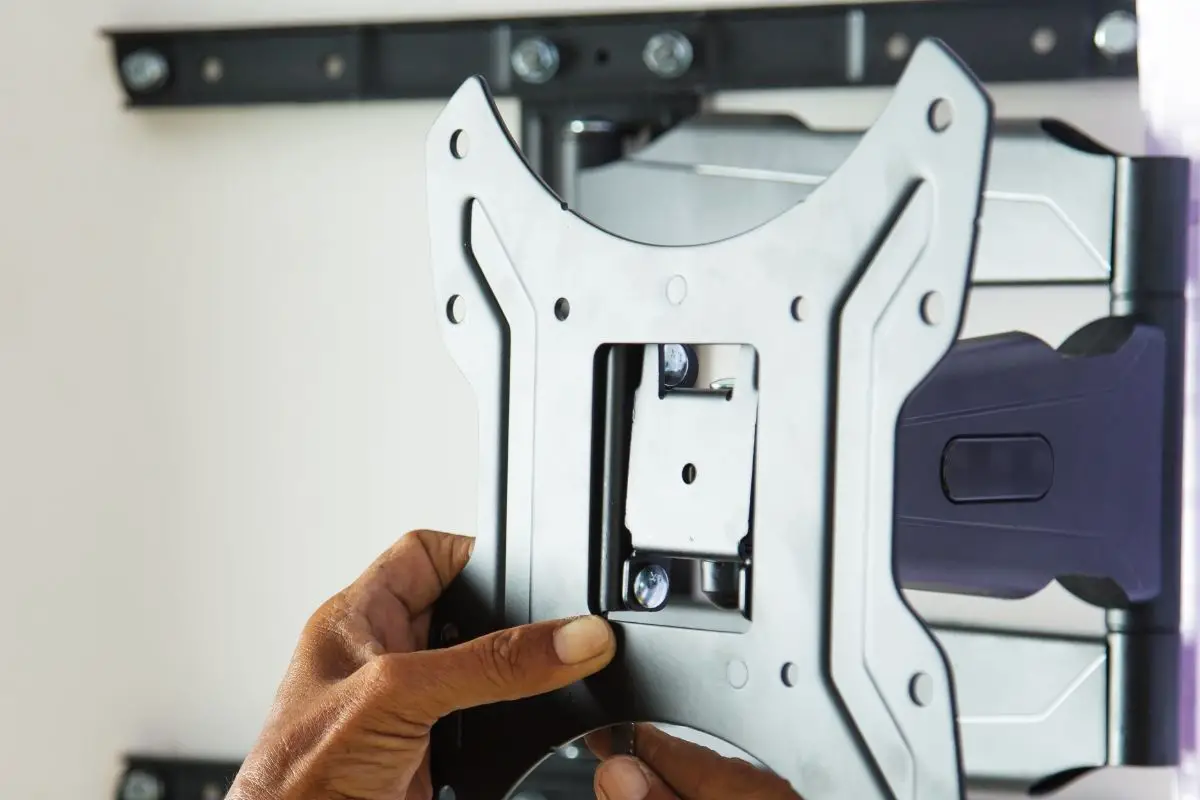
The easiest way to determine the best TV size for your bedroom is to consider how far away you will be when watching it.
If there is little room between you and the TV set on the wall opposite then you should opt for a smaller TV class.
For a larger room with a larger space, you can choose a larger TV as it still won’t dominate the wall.
The viewing height should be the most comfortable for how you decide to watch TV, either leaning back, lying down, or sitting up.
The best TV size may also be determined by the TV screen height. This is calculated from the center of the TV screen to the floor and that total distance should be around 42 inches when measured.
For instance, a 43-inch TV class will have a total TV screen height of 22 inches, so the center of the screen will be 11 inches. That leaves 31 inches of room for the bottom of the screen to the floor.
The same 42 inches from the center of the screen to the floor applies to larger TVs.
One of the largest TV classes is at 85 inches which has a TV screen height of 42 inches so the center will be at 21 inches. That only leaves room for 21 inches from the bottom of the screen to the floor.
How To Install A TV On The Bedroom Wall
Once you have found the right spot for your ideally-sized TV, you can get ready to install it.
This may require some elementary DIY knowledge and some equipment as you want to ensure that the TV is installed securely and correctly.
Any loose fittings could mean that the TV falls off from a height and you really do not want to buy a new one.
You will need the right-sized mounting for the TV size you have chosen, as well as some bolts (or screws), a screwdriver, wrench socket, stud finder, a spirit level, and a drill.
Find The Studs
With a stud finder, locate the studs on the wall for where the TV stand could be installed.
The stud finder is a device that will help you find the wall studs so you can anchor in the bolts and will give you the ideal location to hang your TV.
Two bolts are required for a substantial TV set as it will be both large and heavy so you need the additional bolt to evenly distribute the weight.
Use the TV bracket as a guide for where you want to place the TV then use a marker pen to confirm the spots where the bolts would go in.
You also need a sizeable gap between the TV and the wall for the cables to go.
Also, take the time to make sure that the cables can reach a nearby wall outlet or you may struggle to get the power on without seeing cables going along the floor.
Fasten The Bracket
Now that you have a decent understanding of where the TV will be on your wall and made sure it is at a correct viewing angle, you can fasten on the bracket with your bolts.
You can also use screws if you prefer to and you have a ready supply. Get your equipment ready as you will need your screwdriver (or a socket wrench based on your wall type), the spirit level, and a drill.
Just as a test, when you are mounting the TV bracket, ask someone to lie in bed and confirm that the bottom of the TV can be viewed from that position.
This is the best time to check as you can simply move the TV up until all of the TV can be seen. If the whole of the TV cannot be seen then you will need a higher bracket.
Once you have the confirmation you need, fasten on the TV bracket and get it securely in place.
Bolt On The Back
Once the TV bracket has been successfully installed onto the wall, the other half can be installed with the bolts, or screws, on the rear of the TV.
Continue by just fitting the bolt frames together as soon as you can. The TV should still feel secure though if it feels too heavy for the bracket then remove it and consider a better fitting bracket.
The Importance Of Adequate Lighting
Getting the right height for mounting your TV in the bedroom is important but so is making sure you can see the TV properly.
The lighting is crucial and you should make sure that it does not detract from the viewing experience.
You may believe that watching TV in the dark is ideal yet that may help you get to sleep easier and prevent you from paying attention to whatever you are trying to watch.
Watching TV in the dark also means tiring out your eyes and if you try to stay awake and beat it, that may make it harder to fall asleep.
Being able to binge-watch your favorite TV show may seem important yet an ideal sleeping pattern is much more crucial.
If you have a light dimmer then this is an ideal scenario as you can dim the lights just as you would in a cinema and your eyes should be able to focus and deal with it.
Then again, you could turn the light off and use a bedside lamp instead which can relieve the stress on your eyes.
The Importance Of An Adequate Sound System
Of course, the further away your TV is the harder it may be to hear it. This is where your sound system comes in as you could really benefit from having speakers closer to your position in bed rather than relying on the TV.
If you do rely on the TV then the increased volume may also annoy the neighbors if you share a wall.
One solution is a surround sound system which means external speakers close by keeping the sound nearby instead of being projected across the room.
If the speakers are on either side of you in bed then you can even enjoy stereo audio just as you might be used to in the cinema or from your sophisticated music player.
With high-tech TVs, you may also benefit from wireless headphones which can connect to the TV using Bluetooth technology.
This setup would still let you enjoy stereo audio though you would have to wear headphones/
Frequently Asked Questions
What Is The Ideal TV Viewing Angle?
When you are viewing a TV set, you want to make sure that you can do so comfortably. Not too high and not too low so you are straining your neck, you need it just right.
In order to get the ideal TV viewing angle, you need to achieve the correct position of your TV. The base of your TV, including the tabletop of the TV stand, should be around 25 inches measured above the floor.
For the TV, this should mean a viewing range of between 35 and 45 inches in height which should be comfortable.
This could depend on the size of the TV yet the center of the screen should meet eye level at around 40 inches above the floor.
With that in mind, a viewing angle of around 31 degrees should be just right for the closest, or lowest, viewing distance. For the greatest viewing distance, the angle would be suggested at around 10 degrees.
Should You Mount A TV Above A Fireplace?
While the TV may make the centerpiece of the room above a fireplace, it may not be advisable. That is simply because the area directly above the fireplace tends to be warmer than the other walls in your room.
The excessive heat could melt cables and present a real problem for your TV. The space above your fireplace would be better placed for a clock or a piece of art to offset the appearance of the fire roaring below.
Final Thoughts
Finding the right height and position to mount a TV in your bedroom means taking into account several measurements and considerations.
How you are positioned to watch the TV, the eye level height above the floor, the viewing angle, and the size of the TV.
Once all those measurements have been taken, you can begin to attach the TV bracket on your wall. It is still worth checking that the whole TV can still be seen before you attach it but after that, sit back and enjoy.
- How Do I Connect My Samsung Soundbar To Bluetooth? - February 5, 2024
- How To Connect Soundbar To TV With Optical Cable? - February 5, 2024
- How to Choose the Right Audio System for Your Home Theater Setup - April 25, 2023

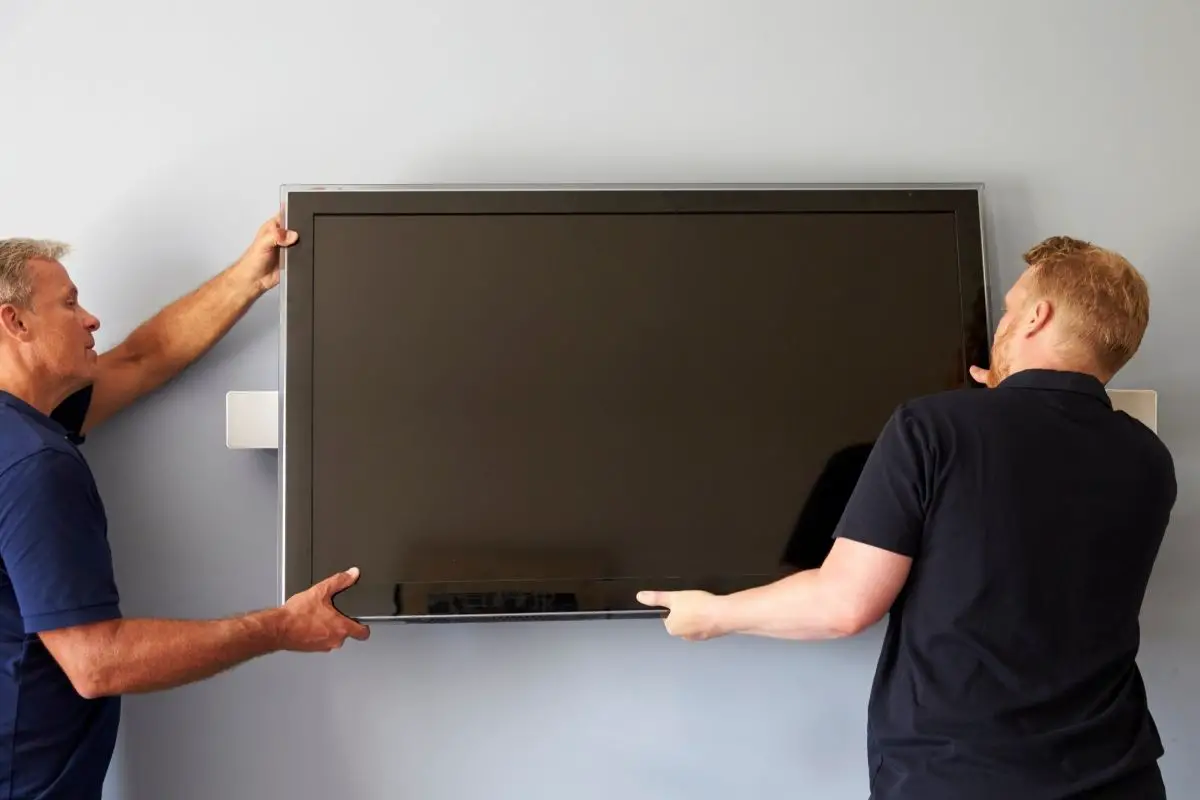
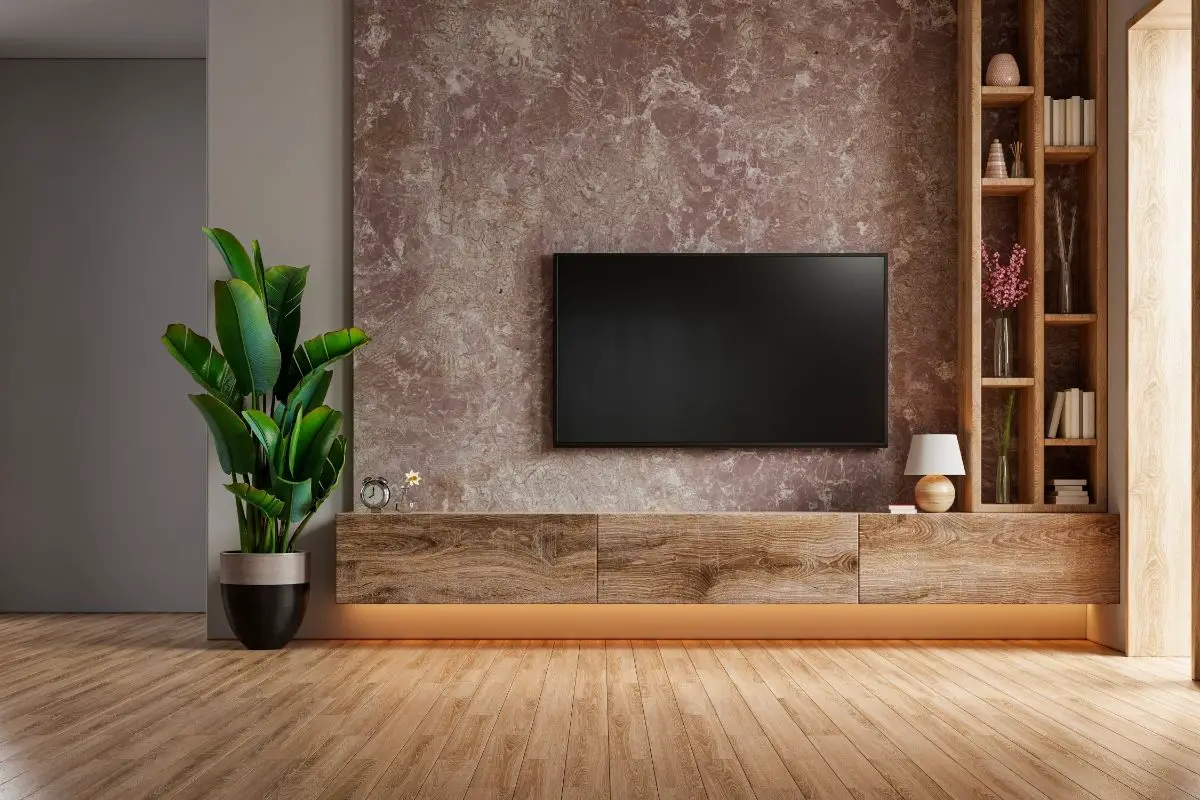
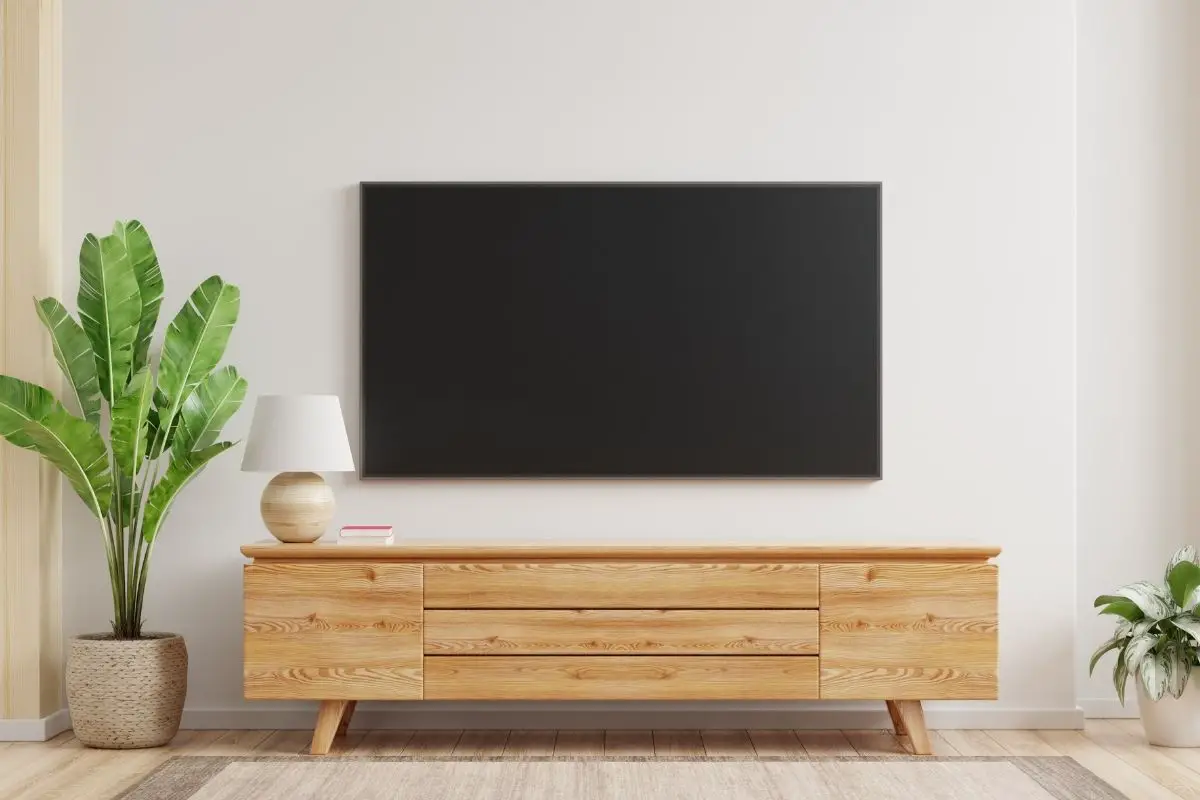

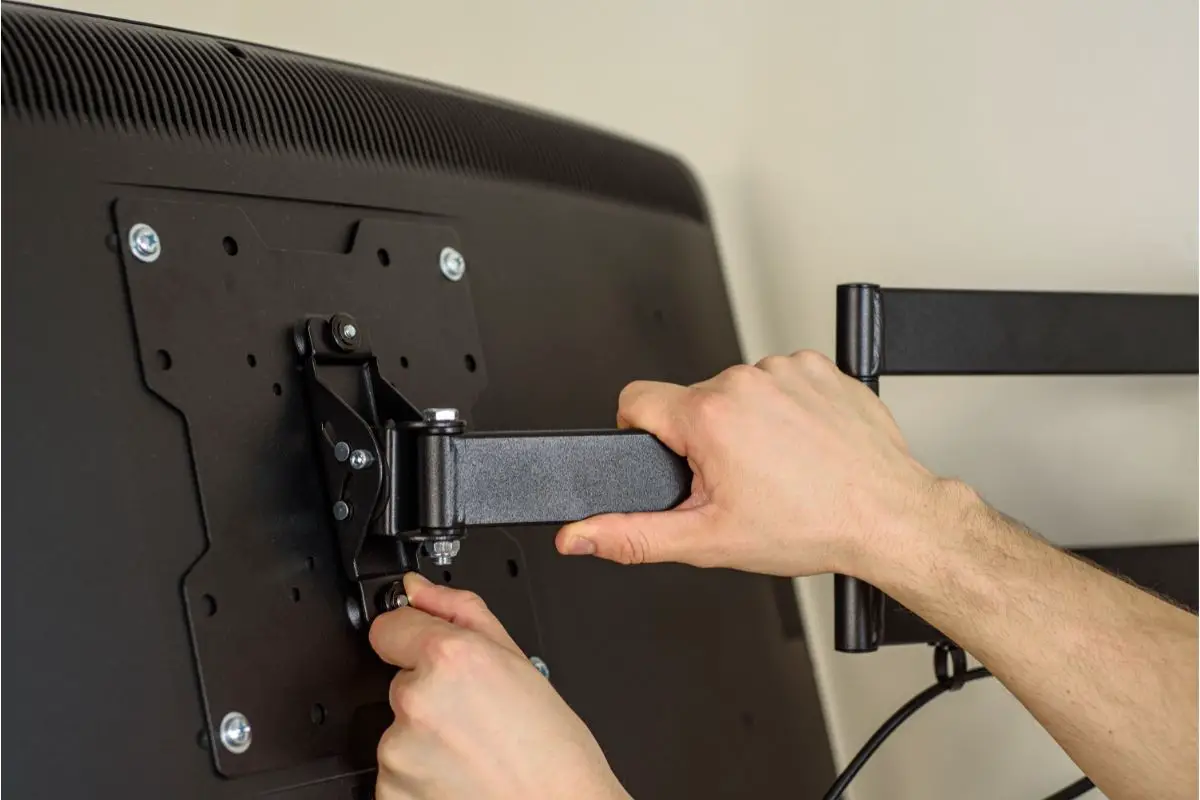
![Bose Soundbar Remote Not Working? [Quick Fix Guide] bose soundbar](https://www.cinemaequip.com/wp-content/uploads/2022/07/bose-soundbar-1-150x150.jpg)
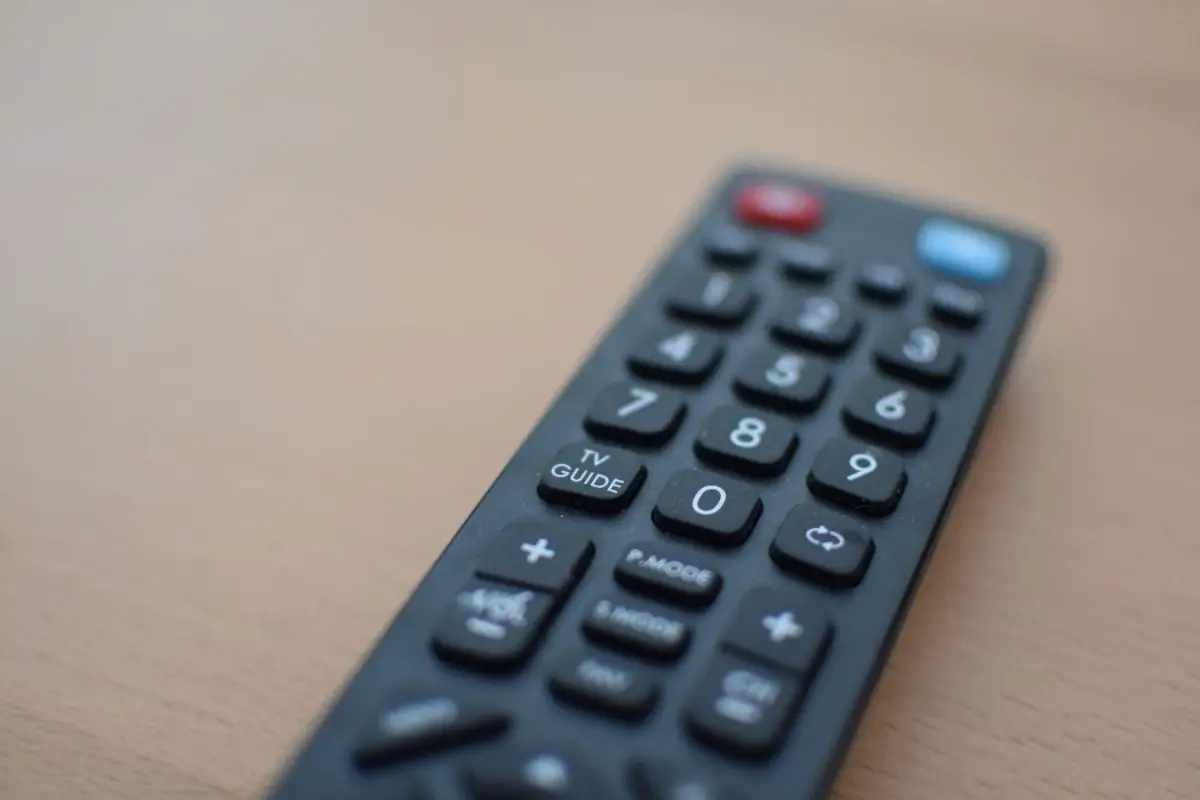
![How To Connect Soundbar To Hisense Roku TV? [Step-By-Step] How To Connect Soundbar To Hisense Roku TV](https://www.cinemaequip.com/wp-content/uploads/2022/07/How-To-Connect-Soundbar-To-Hisense-Roku-TV-1-150x150.jpg)